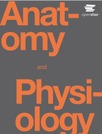
This reading guide is intended to be used with the Open Stax Anatomy and Physiology textbook.
- Subject:
- Anatomy/Physiology
- Material Type:
- Lecture Notes
- Author:
- Bryon Spicci
- Date Added:
- 09/04/2020

This reading guide is intended to be used with the Open Stax Anatomy and Physiology textbook.
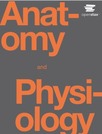
This reading guide is intended to be used with the Open Stax Anatomy and Physiology textbook.

This course is designed to provide an understanding of how the human brain works in health and disease, and is intended for both the Brain and Cognitive Sciences major and the non-Brain and Cognitive Sciences major. Knowledge of how the human brain works is important for all citizens, and the lessons to be learned have enormous implications for public policy makers and educators.
The course will cover the regional anatomy of the brain and provide an introduction to the cellular function of neurons, synapses and neurotransmitters. Commonly used drugs that alter brain function can be understood through a knowledge of neurotransmitters. Along similar lines, common diseases that illustrate normal brain function will be discussed. Experimental animal studies that reveal how the brain works will be reviewed.
Throughout the seminar we will discuss clinical cases from Dr. Byrne’s experience that illustrate brain function; in addition, articles from the scientific literature will be discussed in each class.
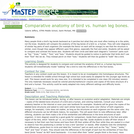
This activity is designed to compare and contrast the anatomy of the leg bones of a bird vs. a human.

Students will learn about condoms as a form of contraception and STI prevention, as well as talk about safer sex strategies, communication, and how to reserach and access healthcare services and testing.

The lesson introduces students to various contraceptive methods used for pregnancy prevention. The lesson ends with a critical thinking exercise that asks students to figure out the best type of contraception for various teens in different situations.

This lesson reviews the basics of safer sex practices and contraception. It also introduces several laws in Oregon that revolve around consent, reproductive and sexual health access, medical consent, and more.

Course materials including an instructor guide, course map, and weekly schedule for the third part of a three-part Anatomy and Physiology class. Includes learning objectives, assignments, formative feedback, learning activities, and readings from the OpenStax Anatomy and Physiology 2e open textbook.

Short video covering DNA replication for anatomy and physiology.
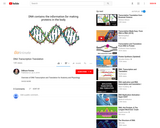
Short video covering DNA transcription/translation for Anatomy and Physiology.
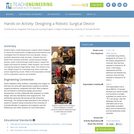
Student teams create laparoscopic surgical robots designed to reduce the invasiveness of diagnosing endometriosis and investigate how the disease forms and spreads. Using a synthetic abdominal cavity simulator, students test and iterate their remotely controlled, camera-toting prototype devices, which must fit through small incisions, inspect the organs and tissue for disease, obtain biopsies, and monitor via ongoing wireless image-taking. Note: This activity is the core design project for a semester-long, three-credit high school engineering course. Refer to the associated curricular unit for preparatory lessons and activities.
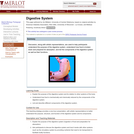
The digestive system is investigated in this learning activity to help participants learn how food is broken down and prepared for absorption, and list the components of the digestive system as well as their functions. Organs investigated include the mouth, esophagus, stomach, small intestine, large intestine, rectum, and anus.

In this video we introduce the digestive system. We look at the two types of digestion: mechanical digestion and chemical digestion. We also look at the two subdivisions of the digestive system: the digestive tracts and the accessory structures.
Lesson 1 in our Digestive System series. This is part of our Anatomy and Physiology lecture series.
If this video helps you please be sure to LST -like subscribe and tell your friends. Your support helps us make more videos. For the complete series please visit http://mrfordsclass.net/
Other Free Videos in the Digestive System series:
-Introduction to the Digestive System (18:01): http://youtu.be/V71Ao98KePI
-The Mouth (18:02): http://youtu.be/-LWqhNaQjvk
-The Throat (18:03): http://youtu.be/guXIwvrUGM4
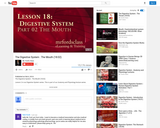
The mouth is our first stop in our digestive system. It is made of our cheeks, lips, tongue, and teeth. We take a look at the mouth as well as the components and how they help with the digestion of food.
Lesson 2 in our Digestive System series. This is part of our Anatomy and Physiology lecture series.
If this video helps you please be sure to LST -like subscribe and tell your friends. Your support helps us make more videos. For the complete series please visit http://mrfordsclass.net/
Other Free Videos in the Digestive System series:
-Introduction to the Digestive System (18:01): http://youtu.be/V71Ao98KePI
-The Mouth (18:02): http://youtu.be/-LWqhNaQjvk
-The Throat (18:03): http://youtu.be/guXIwvrUGM4
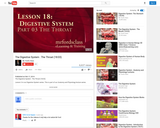
Moving down the digestive system we take a look at the throat. Specifically we examine the pharynx, and the esophagus. We also look at how we swallow, breaking it down into the two phases.
Lesson 3 in our Digestive System series. This is part of our Anatomy and Physiology lecture series.
If this video helps you please be sure to LST -like subscribe and tell your friends. Your support helps us make more videos. For the complete series please visit http://mrfordsclass.net/
Other Free Videos in the Digestive System series:
-Introduction to the Digestive System (18:01): http://youtu.be/V71Ao98KePI
-The Mouth (18:02): http://youtu.be/-LWqhNaQjvk
-The Throat (18:03): http://youtu.be/guXIwvrUGM4

Following the steps of the iterative engineering design process, student teams use what they learned in the previous lessons and activity in this unit to research and choose materials for their model heart valves and test those materials to compare their properties to known properties of real heart valve tissues. Once testing is complete, they choose final materials and design and construct prototype valve models, then test them and evaluate their data. Based on their evaluations, students consider how they might redesign their models for improvement and then change some aspect of their models and retest aiming to design optimal heart valve models as solutions to the unit's overarching design challenge. They conclude by presenting for client review, in both verbal and written portfolio/report formats, summaries and descriptions of their final products with supporting data.

Short Description:
NewParaThis textbook is a project under development by our Biology faculty to ultimately provide students with all the factual information they need to succeed in the BIOL 1103 and BIOL 1109 courses at Douglas College in BC, Canada. If you have technical difficulty downloading this textbook, copy & paste the following direct link into your browser's address bar to allow you download the print .pdf version: https://pressbooks.bccampus.ca/dcbiol110311092nded/open/download?type=print-pdfNewParaNote: This open textbook has been imported into Pressbooks to make it easier for instructors to edit, build upon, and remix the content. There may be formatting errors in the book that need attention. We therefore recommend you review and edit this book before using it in your own classroom. For information about how to get your own copy of this book to work on, see the Clone a Book chapter in the Pressbooks Guide. You can access the original OpenStax version of this textbook on which this version is based here: Anatomy and Physiology
Long Description:
This textbook is a project under development by our Biology faculty to ultimately provide students with all the factual information they need to succeed in the BIOL 1103 and BIOL 1109 courses at Douglas College in BC, Canada. Readers should be aware that the information herein is subject to change at any time as corrections, additions, or other important modifications are made. Current students at Douglas College should be aware that only the most recent version of this textbook will be considered by their instructors to be complete and correct. The most recent version of this second edition will remain accessible online at https://pressbooks.bccampus.ca/dcbiol110311092nded/, and the most recent version of the second edition of the companion textbook (developed for Douglas College’s BIOL 1203 and BIOL 1209 courses) will also remain accessible online at https://pressbooks.bccampus.ca/dcbiol120312092nded/.
This textbook was developed initially as an adaptation of the OpenStax Anatomy & Physiology textbook, freely and perpetually available online at http://cnx.org/content/col11496/latest/. The original adaptations of that OpenStax textbook for Douglas College are accessible online at https://pressbooks.bccampus.ca/dcbiol11031109/ and https://pressbooks.bccampus.ca/dcbiol12031209/ In the first edition of the Douglas College adaptations the chapter and section numbers were left as they were in the version of the OpenStax A&P textbook, from which they were largely drawn. However, this second edition has been more extensively edited and rearranged to correspond with the curriculum used at Douglas College, so chapter and section numbers are no longer aligned specifically with the OpenStax A&P textbook.
Word Count: 114229
(Note: This resource's metadata has been created automatically by reformatting and/or combining the information that the author initially provided as part of a bulk import process.)

Short Description:
NewParaThis textbook is part of a project under development by our Biology faculty to ultimately provide students with all the factual information they need to succeed in the BIOL 1203 and BIOL 1209 courses at Douglas College in BC, Canada. A newer edition is currently in use and is available at: https://pressbooks.bccampus.ca/dcbiol120312094thed/NewParaIf you have technical difficulty downloading the current version of this textbook, copy & paste the following direct link into your browser's address bar to allow you download the print .pdf version: https://pressbooks.bccampus.ca/dcbiol120312094thed/open/download?type=print_pdfNewParaNote: This open textbook has been imported into Pressbooks to make it easier for instructors to edit, build upon, and remix the content. There may be formatting errors in the book that need attention. We therefore recommend you review and edit this book before using it in your own classroom. For information about how to get your own copy of this book to work on, see the Clone a Book chapter in the Pressbooks Guide. You can access the original OpenStax version of this textbook on which this version is based here: Anatomy and Physiology
Long Description:
This textbook is a project under development by our Biology faculty to ultimately provide students with all the factual information they need to succeed in the BIOL 1103 and BIOL 1109 courses at Douglas College in BC, Canada. Readers should be aware that the information herein is subject to change at any time as corrections, additions, or other important modifications are made. Current students at Douglas College should be aware that only the most recent version of this textbook will be considered by their instructors to be complete and correct.
This textbook was developed initially as an adaptation of the OpenStax Anatomy & Physiology textbook, freely and perpetually available online at http://cnx.org/content/col11496/latest/. Note that the Douglas College edition of this textbook has been extensively edited and rearranged to correspond with the curriculum used at Douglas College, so chapter and section numbers are not necessarily aligned specifically with those in the OpenStax A&P textbook.
Word Count: 118754
(Note: This resource's metadata has been created automatically by reformatting and/or combining the information that the author initially provided as part of a bulk import process.)

Short Description:
NewParaThis textbook is a project under development by our Biology faculty to ultimately provide students with all the factual information they need to succeed in the BIOL 1203 and BIOL 1209 courses at Douglas College in BC, Canada. If you have technical difficulty downloading this textbook, copy & paste the following direct link into your browser's address bar to allow you download the print .pdf version: https://pressbooks.bccampus.ca/dcbiol120312094thed/open/download?type=print-pdfNewParaNote: This open textbook has been imported into Pressbooks to make it easier for instructors to edit, build upon, and remix the content. There may be formatting errors in the book that need attention. We therefore recommend you review and edit this book before using it in your own classroom. For information about how to get your own copy of this book to work on, see the Clone a Book chapter in the Pressbooks Guide. You can access the original OpenStax version of this textbook on which this version is based here: Anatomy and Physiology
Long Description:
This textbook is a project under development by our Biology faculty to ultimately provide students with all the factual information they need to succeed in the BIOL 1203 and BIOL 1209 courses at Douglas College in BC, Canada. Readers should be aware that the information herein is subject to change at any time as corrections, additions, or other important modifications are made. Current students at Douglas College should be aware that only the most recent version of this textbook will be considered by their instructors to be complete and correct. The most recent version of this fourth edition will remain accessible online at https://pressbooks.bccampus.ca/dcbiol120312094thed/, and the most recent version of the second edition of the companion textbook (developed for Douglas College’s BIOL 1103 and BIOL 1109 courses) will also remain accessible online at https://pressbooks.bccampus.ca/dcbiol110311092nded/.
This textbook was developed initially as an adaptation of the OpenStax Anatomy & Physiology textbook, freely and perpetually available online at http://cnx.org/content/col11496/latest/. The original adaptations of that OpenStax textbook for Douglas College are accessible online at https://pressbooks.bccampus.ca/dcbiol11031109/ and https://pressbooks.bccampus.ca/dcbiol12031209/ In the first edition of the Douglas College adaptations the chapter and section numbers were left as they were in the version of the OpenStax A&P textbook, from which they were largely drawn. However, this fourth edition has been more extensively edited and rearranged to correspond with the curriculum used at Douglas College, so chapter and section numbers are no longer aligned specifically with the OpenStax A&P textbook.
Word Count: 125273
(Note: This resource's metadata has been created automatically by reformatting and/or combining the information that the author initially provided as part of a bulk import process.)
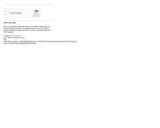
This book teaches healthcare professionals the basics of EKG interpretation and is available as a Creative Commons resource.